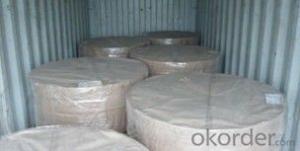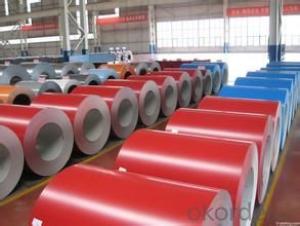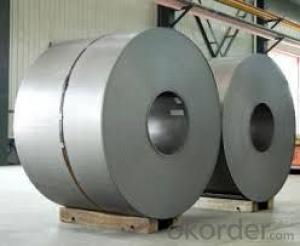Prepainted Galvanized Steel Coil With Best Quality
- Loading Port:
- Tianjin
- Payment Terms:
- TT OR LC
- Min Order Qty:
- 25 m.t.
- Supply Capability:
- 20000 m.t./month
OKorder Service Pledge
OKorder Financial Service
You Might Also Like
Product Name | Prepainted Galvanized Steel Coil With Best Quality |
Brand | CNBM |
Material | DX51D,CGCC,CGCH,CGLCC |
Thickness | 0.14mm-0.8mm |
Width | 750mm-1250mm |
Temper | Full hard,half hard,soft |
Inner Diameter of Coil | 508mm/610mm |
Coating | AZ30-AZ150,Z40-Z275g/m² |
Coil Weight | 2-5mt |
Paint(Top side) | 15-25micron |
Paint(Back side) | 5-10micron |
Color | Ral Chart,as per customer's color swatch |
Paints | PE; HDP; SMP; PVDF |
Application | Structural use ,roofing, commercial use,household appliance,industry etc. |
Package: | Waterproof paper+plastic film+iron packing+bundling,or as per customers request. |
Price terms | FOB,CFR,CIF or as your request |
Delivery time | Within 15-20 days after receipt 30% deposit or L/C at sight |
MOQ | 25 Mt (one 20ft FCL) |
3) Technical Specifications of PPGI steel coil>>>
Test Item | Standard | Result |
T Bend | NCCA11-19 | <3T |
Cupule Test | GB/T9753 | >8mm |
Impact(Shock Force J) | GB/T1732 | >9J |
Adhension(MEK) | GB/T9286 | ≥ 0 |
Pencil Hardness | GB/T6739 | >2H |
Gloss | GB/T1743 | <5% |
Chromatism(E) | ECCA T3 | E<5 |
MEK Scrub Resistance | MCCA11-18 | >100 |
Salt Spray Resistance | GB/T10125 | 500hr |
4) PPGI Prepainted Steel Coil Characteristic >>>
1.Pollution-free and economy
2.Extensive usability
3.Improvement of corporate image
4.Excellent workability, weatherability and elegant appearance.
1) PPGI Prepainted Steel Coil Introduction>>>
Color coated steel is a new prepainted steel product that develops rapidly in the last three decades,which are produced by coating a layer of paint on the surface of cold rolled,galvanized or galvalume coils.The products are made in the process of chemical pretreatment ,initial coating and refining coating by high-speed continuously manufacturing equipment. The coating quality is more smoother,mare stable and more ideal than th quality of brushing.
Color coated can keep the vivid color for a long time with excellent decoration,formability, corrosion resistance and coating adhesion.Color coated steel has become ideal construction material because of its efficient construction, energy conservation and depollution
· Standard: AISI, ASTM, BS, DIN, GB, JIS
· Grade: DX51D,CGCC,CGCH, CGLCC
· Thickness: 0.14mm-0.8mm
· Place of Origin: Shandong, China (Mainland)
· Brand Name: JNC
· Model Number: 0.14mm-0.8mm/750mm-1250mm
· Type: Steel Coil
· Technique: Cold Rolled
· Surface Treatment: Coated
· Application: Structural use ,roofing, commercial use,household appliance,industry
· Special Use: High-strength Steel Plate
· Width: 750mm-1250mm
· Length: Customized or as your request
· Zinc Coating: 40-275g/square meter
· Color: as RAL or as your request
· Trustworthy supplier: Prepainted Steel Coil/sheet
· Coil Weight: 2-5MT
· Paints: Standard Polyester(PE)
· Approved Certificate: ISO9001
· Quality: Top quality
· Test: Will test the products by the Third Part
· Temper: Full hard, half hard,soft
- Q:What are the different jointing methods for steel sheets?
- There are several different jointing methods for steel sheets, including welding, riveting, adhesive bonding, and mechanical fastening.
- Q:What is the average yield strength of steel sheets?
- The average yield strength of steel sheets varies depending on the specific grade and thickness of the steel. However, it typically ranges from 250 to 400 megapascals (MPa).
- Q:What are the different joining methods for steel sheets?
- There are several different methods for joining steel sheets, each with its own advantages and applications. 1. Welding: Welding is one of the most common methods used to join steel sheets. It involves melting and fusing the edges of the sheets together using heat. There are various welding techniques such as arc welding, MIG welding, TIG welding, and spot welding. Welding offers strong and durable joints, but it requires skilled operators and can be time-consuming. 2. Bolting: Bolting involves using bolts or screws to connect steel sheets. This method is commonly used when disassembly or maintenance is required. Bolting provides a strong and reliable joint, and it is relatively simple and quick to perform. However, it may require drilling holes in the sheets and can result in a less aesthetically pleasing appearance compared to welding. 3. Riveting: Riveting is a method that uses metal pins or rivets to join steel sheets together. The rivets are inserted through pre-drilled holes in the sheets and then deformed or expanded to hold them in place. Riveting offers strong and secure joints, and it is often used in applications that require high shear strength. However, it can be time-consuming and requires specialized tools and skills. 4. Adhesive bonding: Adhesive bonding involves using specialized adhesives or bonding agents to join steel sheets together. The adhesive is applied between the sheets, and it forms a strong bond as it cures. This method offers excellent aesthetics as it leaves no visible joints, and it can also distribute stress evenly across the joint. Adhesive bonding is commonly used in industries where welding or other methods are not suitable, such as in the automotive and aerospace sectors. 5. Clinching: Clinching is a method that uses mechanical force to join steel sheets together. It involves deforming the edges of the sheets to interlock them and create a strong joint. Clinching does not require any additional materials such as fasteners or adhesives, making it cost-effective. However, it may not be suitable for applications that require high load-bearing capacity. Overall, the choice of joining method for steel sheets depends on factors such as the application, desired strength, aesthetics, time constraints, and cost considerations. Each method has its own advantages and limitations, and it is important to select the most appropriate method for the specific requirements of the project.
- Q:How much is 2 millimeters per square meter?
- GB two mm steel plate per square weight of about 15.7 kilograms, converted into per square should be 80-100 yuan.Steel plate is made of molten steel, cooled and compressed into flat steel. Steel plate by thickness, thin steel plate <4 mm (thinnest 0.2 mm), thick steel plate 4~60 mm, extra thick steel plate 60~115 mm. The steel plate is divided into hot-rolled and cold-rolled parts by rolling
- Q:Can steel sheets be used for manufacturing agricultural equipment?
- Yes, steel sheets can be used for manufacturing agricultural equipment. Steel is a durable and strong material that can withstand the rigors of agricultural activities and provide the necessary strength and stability required for equipment such as plows, cultivators, and trailers. Steel sheets can be shaped, welded, and fabricated into various components, making them suitable for manufacturing a wide range of agricultural equipment.
- Q:Do the steel sheets have any specific fire ratings?
- Yes, steel sheets often have specific fire ratings due to their inherent fire-resistant properties. These ratings indicate the duration of time the steel sheet can withstand exposure to fire before it loses its structural integrity. The fire ratings are determined through rigorous testing and certification processes.
- Q:Can steel sheets be used for kitchen appliances?
- Kitchen appliances can indeed utilize steel sheets. The preference for steel as a material in kitchen appliances arises from its remarkable endurance, robustness, and corrosion resistance. It is extensively employed in the production of refrigerators, ovens, dishwashers, and other similar items. The malleability and ease with which steel sheets can be shaped and formed into diverse dimensions make them highly suitable for various appliance designs. Furthermore, steel possesses effortless cleanliness, ensuring a hygienic and optimal environment in kitchen settings.
- Q:Are steel sheets suitable for harsh weather conditions?
- Steel sheets are highly suitable for harsh weather conditions due to their durability and strength. Steel is renowned for its ability to withstand extreme weather conditions, including high winds, heavy rain, snow, and hail. Moreover, steel sheets are designed to resist corrosion, rust, and degradation caused by prolonged exposure to severe weather, ensuring their longevity and dependability in any climate. Furthermore, steel sheets can be coated with protective finishes, such as galvanized or painted coatings, which further enhance their resistance to weathering. This aspect has made steel sheets a popular choice for various applications in areas prone to harsh weather, such as roofing, siding, and outdoor structures. They provide exceptional protection and structural integrity even in the most challenging weather conditions.
- Q:What does steel plate "A3" mean?
- Using Q235 steel as punch material, after quenching without tempering, direct use, hardness of 36~40HRC, solved the punch in use in the phenomenon of fragmentation
- Q:What are the environmental considerations of using steel sheets?
- One environmental consideration of using steel sheets is the carbon emissions associated with their production. Steel manufacturing processes, such as iron ore mining and steelmaking, contribute to greenhouse gas emissions, particularly carbon dioxide. Another consideration is the extraction of raw materials. The production of steel sheets requires significant amounts of natural resources, including iron ore and coal. Extracting these resources can have negative impacts on ecosystems, such as habitat destruction and water pollution. Additionally, the transportation and logistics involved in sourcing and delivering steel sheets can contribute to carbon emissions and air pollution. The long-distance transportation of steel sheets, especially if they are imported, can further increase the environmental footprint of their usage. Lastly, the disposal of steel sheets at the end of their life cycle is another environmental consideration. If not properly managed, steel waste can contribute to landfill accumulation and potentially contaminate soil and water sources. Overall, while steel sheets are a versatile and widely-used material in various industries, their production and usage have significant environmental implications that need to be carefully considered and mitigated.
1. Manufacturer Overview |
|
|---|---|
| Location | |
| Year Established | |
| Annual Output Value | |
| Main Markets | |
| Company Certifications | |
2. Manufacturer Certificates |
|
|---|---|
| a) Certification Name | |
| Range | |
| Reference | |
| Validity Period | |
3. Manufacturer Capability |
|
|---|---|
| a)Trade Capacity | |
| Nearest Port | |
| Export Percentage | |
| No.of Employees in Trade Department | |
| Language Spoken: | |
| b)Factory Information | |
| Factory Size: | |
| No. of Production Lines | |
| Contract Manufacturing | |
| Product Price Range | |
Send your message to us
Prepainted Galvanized Steel Coil With Best Quality
- Loading Port:
- Tianjin
- Payment Terms:
- TT OR LC
- Min Order Qty:
- 25 m.t.
- Supply Capability:
- 20000 m.t./month
OKorder Service Pledge
OKorder Financial Service
Similar products
New products
Hot products
Hot Searches
Related keywords





























